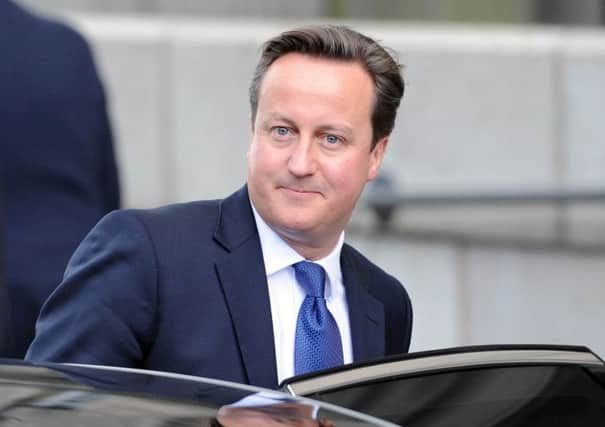Dani Garavelli: Cameron’s Cabinet beauty pageant


Last week, for example, The Onion ran a spoof story which featured Nebraska voters clamouring to find out if Elaine Romero – an Omaha businesswoman supposedly running in the state’s upcoming gubernatorial primary election – “was a mother first and foremost”.
And the Mail – well, I guess you already know what the Mail did. But just in case you somehow missed it, let me fill you in. Less than a week after Harriet Harman bemoaned the discrimination encountered by women politicians, it saw fit to cover David Cameron’s reshuffle by presenting the women he promoted as if they were catwalk models and assessing their suitability for high office on the basis of their clothes, their accessories and the way they walked.
Advertisement
Hide AdAdvertisement
Hide AdEmployment minister Esther McVey was said to have sashayed into the Cabinet. Her hair – “such polish, movement and volume” – met with the newspaper’s approval (phew!) but her thigh slit was “a touch too revealing for a serious Cabinet minister”. At the other end of the scale, the new Environment Secretary, Liz Truss, was described as a “little too 80s air hostess”.
So bizarre was the article – which made no reference to the MPs’ skills, track records or colourful backgrounds – the most common response, even amongst the more politically incorrect, was mockery. The New Statesman ran a piece in which it gave male politicians the full Mail treatment, remarking on the “undeniable erotic charge” of William Hague’s low-cut suit jacket and accusing Philip Hammond of “striding out provocatively in a daring navy suit”. Meanwhile, Nick Clegg tweeted a photograph of himself in Downing Street with the caption, “Hope I’m not too 80s cabin attendant.” There was a degree of mystification too. What motivates a newspaper which employs a large number of female journalists – and has a higher than average proportion of female readers – to run pieces which demean and patronise women? But then Labour MP Helen Goodman called the Tory ministers “puppets” and said “their appearance was the most interesting thing about them”, thus reminding us that casual sexism is not an exclusively male vice.
Of course, the Mail’s piece may have been roundly ridiculed, but many others are guilty of the same belittling attitudes, even as they appear superficially to be pushing women forward. What was Cameron’s female-friendly reshuffle anyway but a glorified publicity stunt in which he exploited a handful of aesthetically pleasing women in an attempt to transform his own image? He might not have christened the girls “Cameron’s cuties”, but by lumping them together in a group labelled “women” – though politically they are very different – and by making them walk up Downing Street in the glare of the cameras, he made it obvious their value to him lay not in their individual contributions but in their gender, and its potential to boost his flagging credentials. Whatever their talents – and most of them had earned their place at the table – they were being promoted because it suited his agenda.
If this kind of tokenism seems familiar, it’s because it is. Just a few months ago, Alex Salmond was facing his own women problems. Specifically, they didn’t seem to like him much or his plans for Scottish independence, so what did he do? First he presented an uncosted plan for 30 hours a week childcare for all three-year-olds. Then, when they failed to fall for that, he promoted Shona Robison and Angela Constance to his cabinet (thus making it 40% female – the proportion his party had set as target for company boards post-independence).
This is tricky territory for a feminist. Clearly, women are under-represented in government. As the all-party parliamentary group on women in Westminster pointed out last week, there are obvious barriers to their success: the boorish atmosphere, the unsociable hours, the unwillingness to provide information on their schedules far enough in advance to organise childcare. Years of waiting for a cultural shift haven’t produced the desired results: at the moment women account for just 22% of all MPs.
Something has to be done. Cameron is said to be open to introducing all-women short-lists if the party does not get more female MPs at the next election. This seems to me to be a good solution at least until the gap has narrowed, even though all-women short-lists can lead to accusations of tokenism and undermine the credibility of successful candidates.
Equally, I can’t regret the influx of women in Cameron’s cabinet, even if, with an election less than a year away, it is the worst kind of gesture politics. The presence of women MPs at the top table or even, as McVey pointed out, on the front page of the Mail – may encourage more women to seek election or advancement. We can only hope that now they’re there, these Tory MPs will grasp the opportunity to demonstrate they have more to offer than their femininity.
So long as their main function is to give the party a make-over, however, their inclusion is no measure of progress on the equality front. The day women are promoted to the front bench on account of their hard work and political acumen, rather than to stop their party from looking like an anachronism, that’s when we’ll finally be getting somewhere. «
Twitter: @DaniGaravelli1